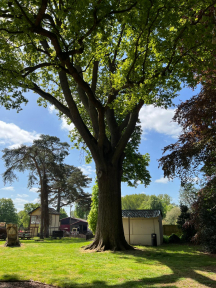
Background on the Queen’s Green Canopy
The Queen’s Green Canopy (QGC) is a unique tree planting initiative created to mark Her Majesty’s Platinum Jubilee. All across the UK people are being invited to “Plant a tree for the Jubilee” to create a legacy in honour of The Queen’s leadership of the nation, which will benefit future generations.
As well as inviting the planting of new trees, The Queen’s Green Canopy has dedicated a network of 70 Ancient Woodlands across the United Kingdom and identified 70 Ancient Trees to celebrate Her Majesty’s 70 years of service.
Our Great Bressingham Oak is one of the 70 ancient trees chosen.
The Great Bressingham Oak is considered old enough to have lived through the reigns of both Elizabeth the First, and Elizabeth the Second. At some point in the past (pre 1800) the main road to Diss passed south of the village Church, Rectory, and Bressingham Hall – and the Great Bressingham Oak. The tree would have witnessed the to-ing and fro-ing of man for c.500 years, walking to work, taking produce to market, or other pastoral business such as moving crops or livestock. In the last couple of centuries the Oak has been the mother of trees on the Bressingham Hall Estate, and annually observed the threshing of wheat in the threshing yard below its boughs, latterly by steam power. The Great Bressingham Oak now overlooks the children’s playground, and provides a backdrop to the working steam engines at Bressingham Steam Museum, and views over Bressingham Gardens.
Adrian Bloom, creator of Bressingham Gardens along with his father Alan Bloom, recounts the story that evolved around the Great Bressingham Oak, which he first saw when only six years old as Alan Bloom and family came in 1946 to live at Bressingham Hall;
THEN
We came to live at Bressingham Hall as the Bloom family in 1946. The oak was already massive then to Adrian as a small boy, and the oak had a commanding view to the Hall in the west, meadows to the east and the north, and farmyard and stack yard to the south. Beside the oak, and planted much too close, was a large Purple Beech, much more climbable than the oak which had enormous but widely spaced branches.
The Great Bressingham Oak was the largest of several wonderful oaks surrounding Bressingham Hall, a country estate then still run on Victorian lines, almost as though time had stood still – horses with wooden tumbrils, farm workers and gardeners who doffed their cap to the owner. Some grew vegetables, or grapes in heated greenhouses, or tended the walled garden and made walkways or “rides” for spring to autumn walks for the family, and shooting opportunities for the country gentlemen in the autumn and winter.
There was one small Massey Ferguson tractor, the rest relied literally, on ‘horsepower’. Six horses and all hands on during the result of the farming year, the harvest. The Great Bressingham Oak looked down on the farm workers loading the stacks of wheat and barley, created with pitch forks throwing it up to the stack builder, the stacks then thatched temporarily until the thrashing machine came to process the corn.
CHANGING TIMES
From 1950 after a settling in period, all began to change. In 1953 my father Alan Bloom began to create the gardens at Bressingham in front of the Hall. My brother Rob and I climbed the purple Beech to nearly the top. We levelled the grass to the north of the Oak and made a tennis court, part in the shade of the Great Bressingham Oak. It’s wide canopy prevented the sun blinding the server, but the light wasn’t great and the grass didn’t grow so well near the tree roots.
The court was moved and but by Adrian elsewhere in 1963, Alan Bloom began his collection of Steam Engines and soon, by 1965 The Bressingham Steam Museum and Gardens became one of the first tourist attractions in Norfolk.
NOW
The Great Bressingham Oak, at around 500 years old, still loftily surveys of its surroundings with 17 acres of garden to the north, and west. To the east is the Steam Museum, to the west the newly refurbished Hall, now a popular holiday-let, and the High Barn which has been rebuilt for weddings and events.
Around 70,000 visitors come each year, the Great Bressingham Oak, due to it’s new found Jubilee celebrity will be more clearly marked for the magnificent stature it has achieved in 500 generally peaceful years (at Bressingham at least) and the value its presence brings to the now world renowned Bressingham Gardens.

MORE ON THE INITIATIVE
By inviting everyone to plant considerable numbers of new trees throughout the country, the QGC seeks to highlight the significant value of trees and woodlands as nature’s simple but highly effective way to clean the air we breathe, slow the impact of climate change, create important wildlife habitats and improve our general health and wellbeing.
- Throughout Her reign, The Queen has planted more than 1,500 trees all over the world and has spoken alongside Sir David Attenborough of the importance of trees in the Earth’s future.
- The QGC is a voluntary and inclusive initiative which is open to participation by everyone in the UK.
- The QGC is a symbolic gift which involves the voluntary dedication of forests and woodland – there is no land/title transfer.
- The QGC is a not-for-profit initiative, which has not received Government funding. Further information about the QGC is available: https://queensgreencanopy.org/ and 70 ANCIENT TREES
A video message from HRH The Prince of Wales, Patron of The Queen’s Green Canopy, filmed under the old Sycamore at Dumfries House in Scotland:

